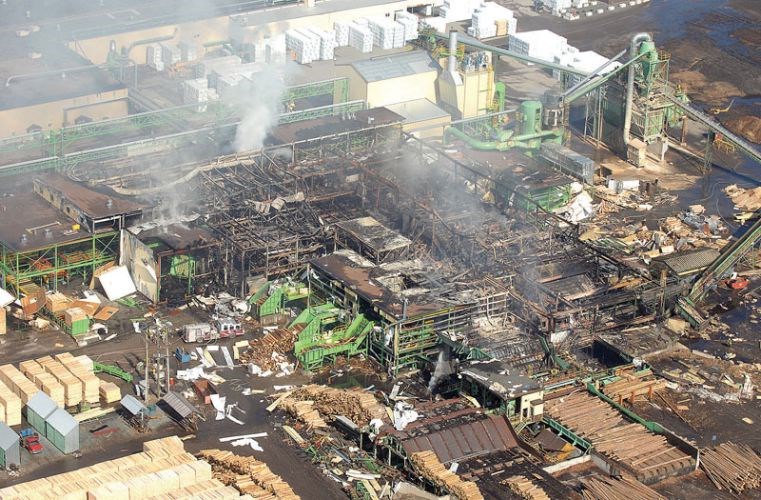Emotions ran high Friday at the coroner’s inquest into the Lakeland Mills sawmill explosion.
A juror burst into tears while questioning Bill Barwise, who was the sawmill’s operations superintendent at the time of the April 23, 2012 blast, prompting coroner Lisa Lapointe to call for a short break.
That came after coroner’s counsel John Orr showed Barwise a series of photos showing high levels of dust in various parts of the mill just 11 days before the blast. They were given to WorkSafe B.C. following the incident.
Orr told Barwise he found his claim “incredible” that the mill was getting cleaner in light of the photos. Barwise agreed the condition shown in the images was unacceptable “with what I know now.”
Like other managers who have testified so far, Barwise said he was well aware of the fire hazard sawdust can create but did not appreciate the potential for an explosion that the material can carry.
As much as 90 per cent of the fibre Lakeland was processing was beetle-killed pine, which broke up more easily than “green” trees and kicked up a dry flour-like dust that would hang in the air and cling to the mill’s machinery and apparatus.
Al Little and Glenn Roche died from injuries suffered in the blast, described as a “deflagration” or subsonic explosion, while more than 20 others were injured, several seriously.
The juror who broke down told Barwise he had worked in a sawmill for 30 years. As he pursued a line of questions related to Curtis Ducharme, who was at the epicentre of the blast and survived only because he was surrounded by mill equipment as the flames blew over him, he became teary eyed and the break was taken.
Barwise had also become emotional himself. He choked up when asked about that night. Barwise, who was not on site at the time, recalled his particular frustration in not being able to reach Little, a supervisor at Lakeland, unaware that he’d been taken to hospital with extensive burns.
“This is horrible on everybody and there isn’t a day I don’t think about this,” he said.
Barwise was also questioned about a failure to interview workers who had witnessed a Jan. 19, 2012 explosion and fireball at the mill’s large headrig as part of an internal investigation conducted by three of the mill’s supervisors, including Little.
A juror told Barwise he had taken courses on how to conduct investigations, “and one of the things that is taught in all those courses is that you must interview everyone that was involved and you must get statements from everyone involved because if you do not, you do not adequately get the scope of the incident.”
In response, Barwise said he did not know why the workers who were at the scene were not interviewed but, in earlier testimony, had also noted one of the supervisors, Bob Sutton, was also there when the incident occurred.
The inquest has also heard the incident occurred at about 3:30 p.m. on a Thursday, just as the work week had come to an end and workers had gone home by the time the investigation had started.
A report was given to Barwise the following Monday that left him with the impression of “spreading fire,” but no explosion.
The inquest has heard a saw at the headrig had gone off track and sent sparks into dust that had accumulate on a hood above the machine sending a burst of flame that nearly touched the mill’s ceiling.
Roche, who was running the machine, and small headrig operator Brian Primrose, got out of their booths and used extinguishers to put the fire out while fellow employees sprayed fire retardant on them from the catwalk above.
Prince George Fire Rescue was not notified, the inquest heard, because there was no structural damage and no one was hurt.
The incident came just a day before the fatal blast that leveled Babine Forest Products near Burns Lake, killing two workers and injuring more than 20 others, and the inquest has heard that it had come close to what eventually occurred three months later at Lakeland.
Barwise now manages the Duz Cho sawmill in Mackenzie, which began operating in mid-2014.
Design features to prevent a dust explosion include locating the mill outside the building with the machines exposed to the elements while the workers remain protected and a vacuum system that runs all the time without a bag house. He said dust audits are completed every two hours.
Mike Richard, then the mill’s general manager, also testified Friday. He admitted never reading the fire code and did not know it prohibits sawmills from continuing to operate when their baghouses, a key part of the dust collection system, are down.
Copies of the fire code can be purchased for about $150, the inquest has heard.
Richard also conceded he should have put greater priority on getting a fire safety plan submitted to Prince George Fire Rescue after it was noted the issue was constantly raised by fire prevention officers in the months and years leading up to the explosion.
Richard said WorkSafe B.C. officials never mentioned a concern about an explosion in a Feb. 6, 2012 visit in response to an anonymous phone call three days before with the caller warning of dust levels and the fear that Lakeland would be the next Burns Lake.
In addition to making recommendations to prevent similar events from occurring in the future, the jury must also decide whether the incident was human-caused or accidental.
The inquest continues Monday at the Prince George courthouse, 9 a.m. start.



